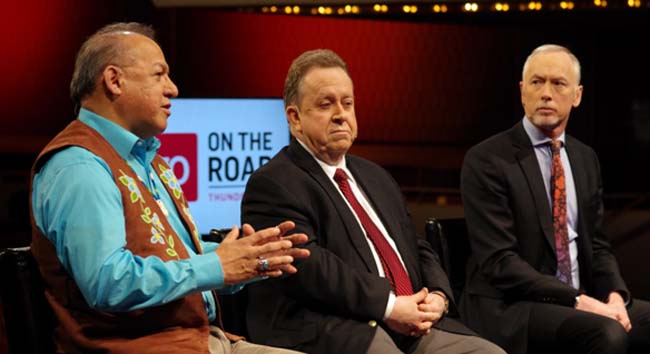TVO’s Agenda tackles northern resource issues

By Rick Garrick
THUNDER BAY – First Nation benefits from an east-west transportation corridor to the Ring of Fire mineral development area were highlighted during a recent The Agenda broadcast in Thunder Bay.
“It’s a good step forward,” says Al Coutts, president and CEO of Noront Resources, one of the mineral exploration companies in the Ring of Fire. “At one point in time we were talking about railroads or big industrial roads. We had lots of different infrastructure views, and now we’ve moved that conversation from a north-south to an east-west corridor that I think the four (First Nation Ring of Fire) communities can really rally around. It works for the mineral proponent, Noront, and it works for both levels of provincial and federal government so it’s a really good step in getting some alignment and traction in the area.”
Northern Development and Mines Minister Michael Gravelle says the east-west corridor provides “full community access” for four First Nation communities in the Ring of Fire area: Webequie, Neskantaga, Nibinamik and Eabametoong. The provincial and federal governments recently announced a $785,000 study on the east-west corridor.
“The Ring of Fire isn’t simply about getting access to a mine site, it’s about having the opportunity to open up the north,” Gravelle says. “The important thing about this particular proposal is (it) is a First Nation initiative. They are very keen to make sure they are very much on the front end of making the decisions on where the access roads go.”
Thunder Bay-Superior North MP Bruce Hyer called for more benefits for First Nations people from the Ring of Fire after the March 8 taping of March 10 TVO broadcast.
“I was shocked the other day when a woman on the other TVO program from the Thunder Bay Regional Health Sciences Centre said they have over 3,000 employees at the hospital and 30 of them are First Nations people,” Hyer says. “So we have one per cent of the jobs at the Thunder Bay Regional Health Sciences Centre going to First Nations people. That is shameful. I truly believe if First Nations people in northwestern Ontario do well, we are all going to do very well. If First Nations people here do not do well, none of us are going to do well.”
Hyer says he was impressed with the high percentage of First Nation employees at Noront’s Ring of Fire exploration camp during a visit to the camp.
“I was totally impressed — they had a very high percentage, I can’t give the exact number but it was at least a third, maybe a half of the employees there were First Nation people,” Hyer says. “The camp was clean, environmentally sound, well run, easy on the environment. I’m really impressed with Noront, and you may know that one of their vice presidents is (former Missanabie Cree chief) Glenn Nolan.”
Coutts says hiring local First Nation people to participate in the Ring of Fire project is vitally important to Noront.
“It’s how we want to do this project,” Coutts says. “There is lots of room for people to benefit from this development and we think the communities nearby — Webequie, Neskantaga, Marten Falls — they should have some of the biggest benefits coming out of this development of anyone.”
Courts says the company recently hired a Ring of Fire Aboriginal Training Alliance graduate from Marten Falls after searching for a cook-medic across the country.
“We’re training local people to do the jobs and to help us develop this mine for Noront and we’re very proud of it.”


